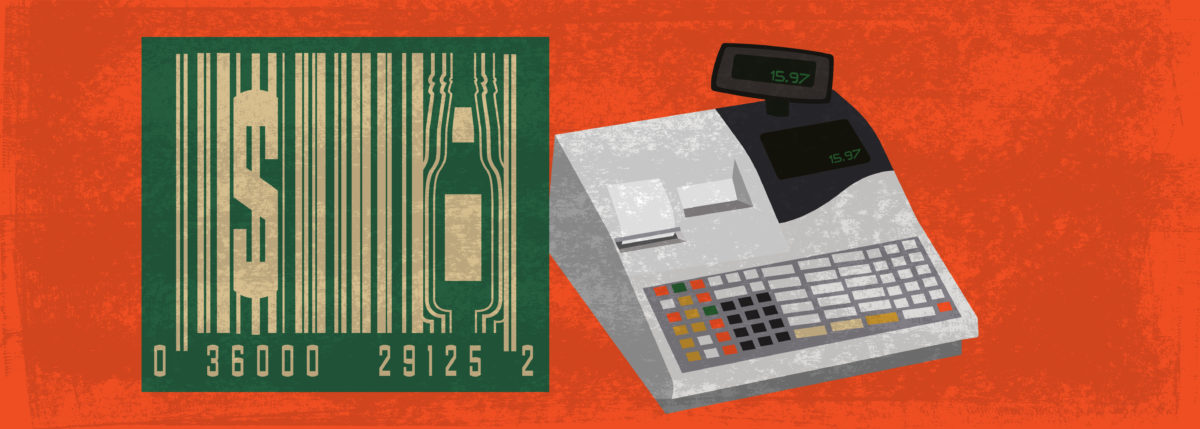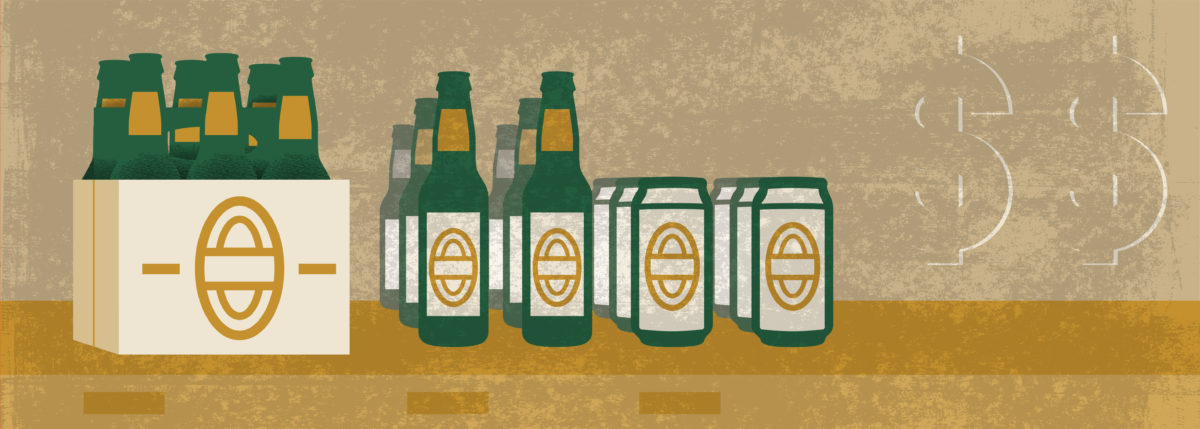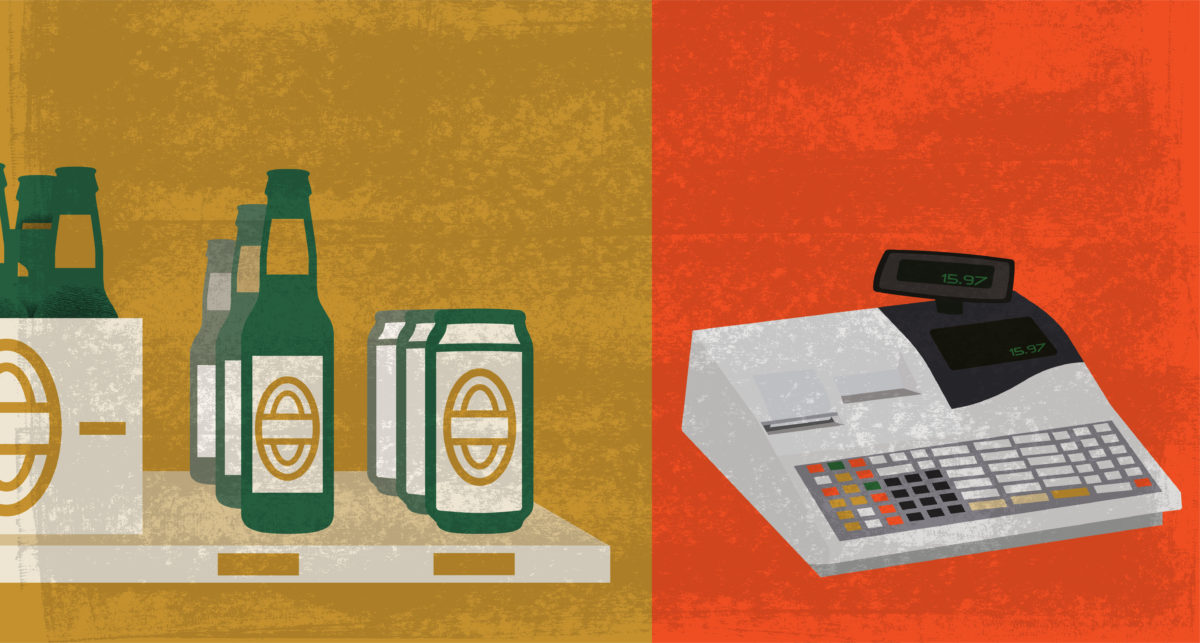Resources
How to Price your Beer and Build Your Portfolio with Bump Williams Consulting
Beer Pricing and Industry Trends with Bump Williams Consulting
If I told you I had a 12oz bottle of beer for sale for $500, would you think that’s expensive or a good deal? Without any other info, would you think that’s an outlandish price?
How about the packaging itself—the beautiful swoop of its neck, the subtle off white coloring of the label, the tasteful thickness of it—it even has a watermark. Does that make $500 easier to stomach? What if I told you it was 1 of 10 bottles available in the world? What if I told you it was 28% ABV? What if I told you it was a plain Jane domestic lager? How do these things shape your opinion of whether or not $500 is a fair price for this beer?
At its core, this is what design (branding, packaging, etc.) does in a CPG context—it communicates messages to shape value. It isn’t about gussying something up for the sake of it, it’s about encoding messages, informing, educating, inspiring and in this context, telling you exactly why something costs what it costs and getting you to buy that something.
Design is how you can come to think that $500 is a great price for 12oz of beer, when you can also buy a 6-pack of domestic lager for $5.
We had the pleasure of sitting down with the Bump Williams Consulting team to discuss this fun subject (among many other valuable points).


Hi, guys (Bump, BK and Dave). Please introduce yourselves and Bump Williams Consulting.
 Bump Williams
Bump Williams
President & CEO of BWC with 30+ years of Beverage Alcohol experience working alongside major brewers while at data and insights companies Nielsen and IRi. Due to his relationships with suppliers, distributors, and retailers, Bump uniquely understands their businesses and interactions between them, providing real-time direction and recommendations to BWC clients.
 Brian ‘BK’ Krueger
Brian ‘BK’ Krueger
VP Business Development & Portfolio Strategy with 20+ years in the Beverage Alcohol arena. BK’s wide range of 20+ years in the Beverage Alcohol arena covers leading teams and implementing projects in all aspects of supplier sales and sales support, including training, organization development, territory expansion, export management, budgeting, deliverable strategy, sales programming, and field quality assurance.
 Dave Williams
Dave Williams
VP Analytics & Insights with 15+ years helping companies find answers to their questions and forecasts for their future. Dave helps BWC clients understand their customers and consumers, evaluate their sales performance, and better understand the Beverage Alcohol industry…what is working, and what isn’t. He makes sure our clients have a clear understanding of their business issues, our recommendations, and how to take action.

What are some of the ways you partner with breweries? How do you help them?
 Bump Williams
Bump Williams
Whether a start-up or well-established, we help to guide breweries in several different ways depending on their current needs. Our services range from Customized Analytics, National Account/Class of Trade Strategies, Shopper Insights, Sales Team Training…and anything in between. We have a lot more specifics listed out on our website, but I think what separates us is our client service & personal touch approach to the process. We get to know the business and try understand where the biggest needs exist today & develop a specific plan of action to address those needs.

I’ve heard you give a great breakdown of the craft beer industry by price level (e.g. premium, super premium, apex craft). Can you recap that so our readers understand how you look at the industry?
 Bump Williams
Bump Williams
The Craft segment is extremely deep with well over 9k Brewers and an exponentially higher count of Brands and SKUs/Packages, so we always try to find different ways to dissect or “bucket” this vast universe in order to better understand where growth is (or is not) coming from. For this specific pricing analysis you reference, we looked at the Average Case Price to Consumer across all craft brands that we are tracking in our data & classified them across 4 tiers:
- General Craft = <$40/Case
- Premium = $40 – $49.99/Case
- Super Premium = $50 – $59.99/Case
- Apex = $60+/Case
What we have seen in recent years is that although the majority of overall $ sales remain in that “General Craft” price tier, there have been times where the incremental GROWTH for Craft is either solely or primarily being driven by those Premium+ price tiers. These learnings indicate to us that consumers have been willing to climb the ladder & spend a bit more on the brands they trust, the brands they enjoy and the brands that they feel justify those higher price points.
It is important to stress here that ALL price tiers play a vital role in the health & wellness of the Craft segment, but those healthy trends among higher price tiers would also indicate that price point is not always a deterrent when it comes to purchase behavior within Craft & to avoid leaving money on the table when it comes to pricing your products appropriately.

I’ve always been interested in how market pricing—I’m not sure what else to call it—can limit a brewery’s ability to raise the price of a flagship 6-pack. E.g. most other similar sized breweries and styles sell for 9.99 / 10.99 / 11.99 etc. per 6-pack in our region, so that’s what we have to charge.
Two questions.
1. Setting aside COGs, is there a psychological (behavioral economics) element to this? Is there a magic price point for a specific style that you can’t breach?
 Bump Williams
Bump Williams
In any market you want to have an awareness of the pricing landscape for like-style, similar-format competition since that is who you will be sitting side by side against on the shelf. Taking it one step further too, we would also want to look at exactly who are the top-sellers, who are the top growth brands & how do sales, share & trends shake out across that specific competitive set. These types of analyses would give you an idea of any soft ceiling that might exist in the market and where price sensitivity starts to dial up.
Another thing to consider is that these price ranges can, and often will, vary depending on the style. Higher ABVs, special releases, Imperial Stouts and Belgian ales for example can fall on the higher end of the spectrum vs. other options on the shelf.
At the end of the day however, a lot of pricing decisions are ultimately influenced by:
- What will keep the brand profitable for the Brewer?
- What will keep the product competitive on the shelf?

2. Setting aside the (completely subjective) conversation about what constitutes “good” package design—how much does branding and marketing help a brewery increase retail price? Ballast Point, for instance, famously charged $16+ for a 6-pack of Sculpin for years.
 Bump Williams
Bump Williams
This goes back to one of the statements we made above in that a craft shopper might be less sensitive to the sticker price as long as they perceive the product to justify the cost, and often times a lot of this perception is tied to quality as well as reputation, both of which can be tied in some form to the branding and marketing. Developing a “branded story” that effectively communicates the origin, the values and the points of differentiation that your brewery is built on & that the consumers can immediately recognize at retail can go a long way.
A well-developed and authentic “branded story” has the ability to drive awareness and trial while also directly connecting to the quality and reputation of the brewery, which is what ultimately “justifies” a premium+ price point in the eyes of the consumer.


We’ve had conversations with breweries and a few distributors over the years about consumers doing mental math when shopping to figure out the price to ABV ratio. E.g. Comparing a 12oz 6-pack of 6% IPA for 10.99 to a 16oz 4-pack of 7.5% IPA for 13.99, and using this to guide their purchase decision.
I’ve always been skeptical of this idea—is there any data to back this up?
 Brian
Brian
I am not sure there is a high percentage of the general craft consumers out there that are taking those extreme of steps to run ratios when making a decision at the shelf. When it comes to package configuration and/or ABV, I believe that most of the decision-making criteria center around the specific occasion for said purchase.
For instance, a higher volume consumption occasion might call for a 6-pack or 12-pack while an occasion for more paced consumption might call for a 4-pack or even a single-serve. A lower ABV also lends itself toward a higher volume/ frequency occasion vs. a higher ABV which lends itself to a lower volume/frequency…when drinking responsibly.
Also, assuming we would be considering different brands being offered in different formats in this scenario, you could also assume that characteristics such as can vs. bottle, style attributes and brewery / brand affinity could also come into play in regards to the “decision tree” that a consumer would make at the shelf more so than a “bang for your buck” ratio.

Let’s talk about price bracketing for smaller breweries. Is there any merit to releasing a lower priced product and/or a higher their offering to give customers a more diverse mix of products? I think both would have potential pitfalls from a positioning and brand architecture standpoint, but I’m curious what you think purely from a price standpoint?
 Dave
Dave
One thing we know about the Craft segment is that it certainly doesn’t hurt to have a diverse portfolio in terms of offerings. For example, IPAs are a huge component of craft beer for sure, but they only account for 40-45% of total sales which means that over half of Craft dollars are being spent outside of the IPA style. The same concept can be applied when it comes to providing multiple tiers within your portfolio.
For the core portfolio, there are a number of benefits when it comes to being line-priced. Consistency when it comes to managing gaps vs. competition, consistency when it comes to margins & consistency when it comes to retail execution/programming.
However, there are also benefits to tiered offerings as well. Special releases, rotational series, barrel-aged, high ABV…these next-level offerings might come at a more premium price point, but what they might lack in scale can often be offset when it comes to margin/profits. On top of that, now you have the ability to keep these special occasion purchases in your family vs. a consumer looking elsewhere to fill the void.
There have also been some successful examples of lower-priced multi-pack SKUs that provide the consumer with a more “value-driven” offering. The watch-outs with this approach however are inherently tied to margins & the risk of commoditizing your brand at the expense of the SKUs that do generate the desired profits.
In short, the approach certainly varies depending on the business model of each brewer and it really comes down to focus. Keep the focus on the core business that keeps the lights on, but there is certainly room to supplement that core with strategic offerings alongside it that could lead you into new accounts or new opportunities that might not be a “best fit” for your core lineup.

I’ve wanted to ask you about non-alcoholic beer pricing. My hunch is that NA beer pricing can skew higher because you’re buying a healthy alternative. Many health-forward products carry an accepted premium because it’s viewed as an investment rather than an expenditure. Is this the right take or am I missing something?
 Brian
Brian
At the end of the day, the goal for a lot of these new wave Non-Alcoholic beers was to offer an alternative to consumers who want a beer experience, just without the effects that come with the inclusion of alcohol. For that reason, I think they view these brands on a level playing field when it comes to pricing & positioning vs. their “full strength” counterparts. I don’t believe that these NA brands are viewed as trading consumers up in terms of price but rather just introducing a Beer product into an occasion where beer might have previously not been considered (ex. work lunch, family outing, outdoor sports/activities). The added bonus with these NA brands is in the incremental purchase occasion for beer drinkers and the new shoppers from what were previously non-Beer drinkers.

The “Beyond Beer” category is on fire right now. Do you think we’re still in the early days / sprint phase of these categories and that eventually, things will level out? Or does this incursion into overall beer share continue for years?
 Bump
Bump
Right up front, the definition of “Beyond Beer” might differ depending on who you are talking to, so I’ll be specific when it comes to the recent emerging areas within Beverage Alcohol we are seeing develop.
For a massive category like Hard Seltzer, we are currently seeing YoY growth rates start to slow down as the YA sales comps get bigger, the consumer base becomes more saturated and retail shelves start to run out of places to put all of the new still in the pipeline. Seltzer is still a healthy category and responsible for much of the incremental gains we see today… but I do believe that we might be approaching that plateau phase of the life cycle unless there are some major shakeups on the horizon.
For other emerging areas such as Ready-to-Drink Cocktails (RTD), Non-alcoholic, hard kombucha, CBD/THC Beverages and the like, I think there is certainly still a runway for these categories to grow and potentially source occasions away from “traditional” beer. Each category faces its own barriers in terms of class of trade restrictions, potential consumer base and legal hurdles, but there are pockets across the United States where these categories have caught fire and have plenty of room to expand in terms of distribution, HH penetration and cross-category sourcing.


Build a stronger brand.
Sell more beer.
Join 7,500+ other beer industry folks and sign up for our monthly Beer Branding Trends Newsletter.

Beer Branding Trends 2.0

What do you make of super hype-y $20+ 4-packs? The pandemic seems to have not touched this market and I’m wondering when/if that market will burst.
 Dave
Dave
With craft, this has been one of those constants throughout the years in the form of the “White Whales” or “Beer Hero” experiences for consumers. Whether it’s tied to a specific brewery, a specific special release or a specific style, there seem to always be a place for these Apex-tier offerings. At the same time, these price points are most often associated with the Direct-to-Consumer purchases as opposed to those sold nationally in major retail chains (with some exceptions, of course). And because those on-site, brewery-only experiences are a foundation of craft, I do not expect that bubble of “Must Have 4-packs” to ever burst.

Can a smaller brewery (say, ~5k bbls per year) compete with a 12 or 15-pack format?
 Dave
Dave
When you talk about the strategy behind multi-pack formats, in most cases these are the volume-driving SKUs as well as the packages most often used for promotions at retail. So, understanding that…
For 12-packs, this is almost becoming a must have format for any craft brewer who wants to start doing big business in retail chains. This is by no means necessary to succeed, but this is that next level package that should be implemented after building your foundation with smaller formats. Ultimately, for a small brewer, venturing into 12-packs would depend on the which specific brand would be going in & where the desired margins for that brand would put the everyday price to consumer. Would the price point keep the format competitive, or would you price yourself out of contention?
For 15-packs, this is always a difficult format for any brewer to introduce and to make a sizable profit on because in most cases they compete at or close to 12-pack prices. Not only would this apply to “smaller” brewers, but often to many larger ones as well. Most brewers tend to shy away from 15-packs to avoid playing any sort of deep value or price point floor games because it is typically a losing venture when going head-to-head with the current leaders in this space.

Can a brewery survive (stay relevant and viable) with only flagships in 2021 or does it need small batch releases to keep people interested?
 Brian
Brian
This is a bit of a 2-part answer which pertains to a brewery’s health at retail because I would assume that most brewer’s these days would offer a core lineup + rotating and new offerings on-site at their taproom…which is essential.
First, yes, a brewery can survive and stay relevant with only flagships because there is always room for these flagship brands/SKUs to continually go deeper into chains at “home” and drive incremental sales through ongoing expansion. Get that first brand onto the shelf, then start flanking it with your other core offerings. After going deep, then you can start expanding that lineup into adjacent markets. Once you’ve built a banner of brands on retail shelves in your core footprint, then start to mix in new package formats to meet new occasions…12-packs, single-serve. Keep the portfolio diverse by hitting the key styles in the area (IPA, Seasonal, Variety Packs, Hazy, etc.). A brewery can do a lot with a well-diversified core lineup of brands although it will require constant maintenance if a brand starts to soften.
Second, small-batch releases certainly do help to keep interest levels high, but the role of these is to compliment the core lineup as incremental offerings and are usually not doing the heavy lifting. In some cases, small batch releases that are well received might translate into a year-round offering, but in most cases these serve as a hook to drum up foot traffic and to create incremental purchase occasions for the brewer on top of the core.

Money is no object… what type of brewery / concept are you building in 2022?
 Bump
Bump
Own the “hometown” model…small scale, incorporate the community, package/draft to-go. Be a destination for the town and take baby steps once we learn to walk! It is a very competitive landscape out there, can never rest on your laurels and get complacent, You need to always be protecting the space you’ve earned and fighting for the space you want next.


Everyone’s trying to figure out what the lasting effects of the pandemic will be on the beer industry. Can you give us two or three changes that you think stand a good chance of sticking around over the next four or five years?
 Brian
Brian
- Cocktails/beers to-go
- Self-distribution
- Portfolio expansion beyond beer (e.g. Seltzer, RTDs, NA, Kombucha)
- Brewer’s increased focus on 3-tier and chain business, the need for multiple avenues to reach consumers instead of only on-site

What are you worried about for the brewing industry as we make our way past the pandemic?
 Bump
Bump
What will be the long-term impact of shortages (packaging, ingredients, labor)? How many brewers will see lost occasions or lost business altogether simply because they were unable to get the product on the shelf to meet the consumer demand… and if those occasions are lost, will they come back?
Will spirits continue to source volume from beer at the same rate that we see today behind the recent surge of Tequila, Whiskey and RTD cocktails? There may be some pockets of success for beer to cling to, but we continue to see occasions lost to spirits which does not bode well for the long-term health of beer.

What is the biggest positive pandemic-induced change you see for the beer industry?
 Bump
Bump
I think brewers, wholesalers and retailers alike were all forced to undergo a bit of a SKU rationalization in order to clean up the clutter and really focus on what is and is not helping to grow their respective businesses. The bad news is that sometimes those realizations do not always align but hopefully the general outcome is a more efficient and focused path to market.
I think we also saw the mettle get tested for a lot of brewery leadership and in the cases where the brewery was able to weather the storm, I think they came out stronger on the other side with a better understanding of what works and what needs attention in their business to succeed in the long-term.

Do you have any book / podcast / newsletter recommendations that beer industry folks should check out?
 Bump
Bump
We recently recorded a few interviews with Justin Kendall at Brewbound [NOTE: Brewbound subscription required to listen] and Harry Schuhmacher of Beer Business Daily, so those are a couple options that offer their own interpretations of recent developments across Beer.

Beyond those, how do you stay sharp and up-to-date on emergent trends?
 Bump
Bump
The easy answer is simply by having regular conversations. Whether that is with our Brewer, Wholesaler & Retailer clients or with friends and acquaintances we’ve made along the way. We are also constantly analyzing the latest data we can get our hands on that is either feeding into our monthly newsletter, incorporated into current projects or just to check in on what’s new out there.
One of the other big things is that before Covid we were a big face-to-face type of company, so we were always in new markets where we could ask about local developments. Thankfully those types of interactions have been picking back up lately although we remain cautious based on the day-to-day developments on that front.

We believe good design is good business. What have you seen, or directly influenced through BWC, that backs up this claim?
 Bump
Bump
I would tend to agree on that claim since in a lot of cases for beer, brand or package design can often be the very first experience that a potential consumer has with a product… particularly for craft where the universe is vast and there are still new breweries popping up every day. Couple that with the level of promiscuity we continue to see in craft as it pertains to brand hopping or the renewed post-Covid vigor surrounding innovation, sometimes it’s the design alone that helps you to get recognized unless there has been some word of mouth that precedes you.
Clarity on style, clarity on the manufacturer and brand, and clarity on the attributes tend to be featured prominently. Hazy is still very much in play with craft, so we see that style/attribute often being brought to attention. Expanding on another topic we touched on above, we have also seen a lot of brands touting the word “low” (ABV, Calorie, Carb) in their design. Communicating the benefits of the brand to potentially unaware shoppers.
We’ve also seen a lot of attempts to create synergies through a connected brand family. Assuring consumers that the core attributes of a well-known brand have been carried over into new extensions, each with their own twist on the classic (ABV, Flavor, Aroma, Profile, etc.).
Whatever a company can do to put themselves in a position to succeed or to warrant consideration over competition through design sounds like good business to me.

Build a stronger brand.
Sell more beer.
Join 7,500+ other beer industry folks and sign up for our monthly Beer Branding Trends Newsletter.
